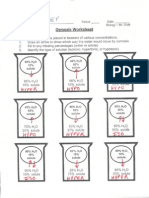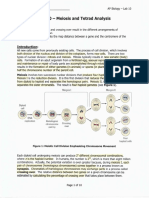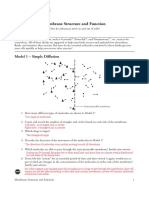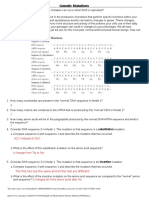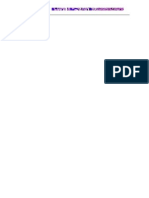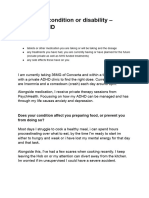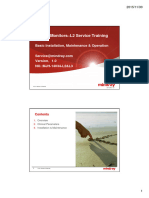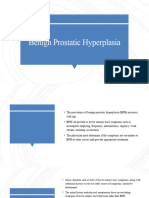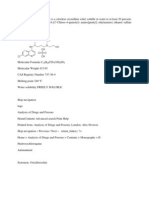POGIL Control of Blood Sugar Levels PDF
Uploaded by
Joey MaPOGIL Control of Blood Sugar Levels PDF
Uploaded by
Joey MaAnswers
Answer Key joeyma.club
Answers Key
Key
Control of Blood Sugar Levels answer
Control of Blood Sugar Levels Pogil
Control of Blood Sugar Levels key
Control of Blood Sugar Levels
What hormones are involved in the homeostasis of blood sugar?
Why?
All living things use glucose as a source of energy. In vertebrates it is critical that the levels of glucose in
the blood are consistent. Small fluctuations are fine, but if the glucose concentration in the blood gets too
high, a coma could result. If the glucose concentration in the blood gets too low, the person could experi-
ence seizures, go into a coma or die. In humans, hormone levels help regulate the glucose concentration in
the blood and keep us in homeostasis.
Model 1 – Hormonal Control of Glucose
Insulin
Relative Concentration in the Blood
Glucagon
Glucose
Glucose baseline
Insulin baseline
Glucagon baseline
Meal Eaten
Time
1. The relative blood concentrations of which three molecules are recorded in the graph of Model 1?
Insulin, glucagon, glucose
2. Which molecule from Model 1 is found in the blood at the highest concentrations?
Glucose
3. Why do cells need glucose?
Cells need glucose for energy for cellular respiration to make ATP
4. According to the graph in Model 1, what happens to blood glucose levels after a meal has been
eaten?
Blood glucose levels increases
Control of Blood Sugar Levels 1
5. Refer to Model 1.
a. As blood glucose levels increase above baseline, the level of which hormone also increases?
Insulin
b. As blood glucose levels begin to drop below baseline, the concentration of which hormone
increases?
Glucagon
c. As blood glucose returns to its baseline level, what happens to the levels of insulin and gluca-
gon in the blood?
The levels of insulin and glucagon returns to their baseline levels
Model 2 – Feedback Control of Blood Glucose
Pancreas Liver
ge
Stora
Use
d Other cells
Blood Blood
glucose Cycle A glucose
is too high. drops.
Glucose
Baseline blood Insulin
glucose level. Glycogen
Blood Glucagon
glucose rises. Blood
Cycle B glucose
is too low.
Pancreas
Release
Liver
2 POGIL™ Activities for AP* Biology
6. According to Model 2, what are three of the organs/tissues of the body that interact to regulate
blood glucose levels?
Liver, pancreas, and other cells such as red blood cells
7. According to Model 2, where in the body do the insulin and glucagon originate?
Pancreas
8. Refer to Model 2.
a. What shape in the model represents glucose?
Hexagon
b. Describe how glycogen is related to glucose.
Glycogen is a polymer of glucose monomers
c. Which form of sugar, glucose or glycogen is stored in the liver for future use?
Glycogen
Read This!
Most cells in the body have insulin receptors. When insulin is present, the transfer of glucose into cells
increases. This takes the glucose out of the bloodstream and puts it where it can be used, or in some cases
stores it as glycogen. The glycogen can be converted back into glucose when it is needed. But glycogen
cannot be used by cells directly as an energy source. Excess glucose that remains in the blood gets excreted
out in urine.
9. Refer to Model 2.
a. In which cycle is glucose removed from the blood by storing it or moving it into cells to use
for fuel?
Cycle A
b. Which hormone, insulin or glucagon, helps glucose move into cells of the body?
Insulin
c. In which cycle is glucose added to the blood from storage areas?
Cycle B
d. Which hormone, insulin or glucagon, helps turn glycogen into glucose?
Glucagon
Control of Blood Sugar Levels 3
10. In grammatically correct sentences, explain the role of insulin in maintaining glucose levels after
a large meal.
After a large meal, blood glucose levels rise causing the pancreas to then
release insulin. This presence of insulin increases the transfer of glucose
into the cell where glucose can be used or stored for energy. As glucose
moves inside the cells, blood glucose levels decreases.
11. In grammatically correct sentences, explain the role of glucagon in maintaining glucose levels
when the organism is hungry.
When the organism is hungry, blood glucose levels decreases below the
baseline which causes the pancreas to release glucagon which then releases
glycogen from the liver and muscles. As glycogen converts into glucose,
blood glucose levels increase.
12. For each of the cycles in Model 2 identify the stimulus and response for the feedback loops and
indicate whether the feedback loop is positive or negative feedback.
Stimulus Response Positive or Negative?
Cycle A High glucose levels Release of insulin Negative
Cycle B Low glucose levels Release of glycogen Negative
13. Predict the levels of glucose, glucagon, and insulin in a person who has:
a. Skipped a meal.
Low glucose, high glucagon, low insulin
b. Just run 5 miles.
Low glucose, high glucagon, low insulin
c. Just ate a large dinner.
High glucose, low glucagon, high insulin
4 POGIL™ Activities for AP* Biology
Extension Questions
14. In the past, diabetes mellitis was diagnosed by tasting the urine of the patient. What evidence for
diabetes were the doctors looking for?
If the urine tasted sweet, it would indicate diabetes because glucose was not
absorbed by the cells.
15. In Type I diabetes, the Beta cells of the pancreas produce little to no insulin. What effect does
this have on an organism’s ability to regulate blood glucose levels?
The movement of glucose into cells remain at their constant levels and increase
at low levels. Blood glucose levels remain high after a meal. The blood glucose
levels decrease when cells use glucose for energy.
16. Type I diabetics must eat frequent small meals. Explain why this is necessary using what you have
learned about blood glucose regulation.
Eating frequent small meals is necessary because in type I diabetes, the
pancreas produce little to no insulin. The movement of glucose into the cell will
remain at their constant level or will not increase. Eating large meals will cause
their blood sugar levels to drastically increase due to insulin resistance, and
excess glucose does not enter the cell and remains the in the bloodstream
where it is then it is excreted in urine.
17. Other symptoms of Type I diabetes are increased thirst and frequent urination. Explain these
symptoms using what you have learned in this activity as well as your knowledge of osmosis and
diffusion.
In diabetes, there is a high concentration of glucose in the blood because the
body can not produce insulin and therefore not absorb glucose, so the blood
will have more solute than the cells. This causes the fluids to move from the
cells to the blood. The increased amount of water in the fluids will need to be
filtered and disposed by the kidneys by urine, so the kidneys will excrete the
excess glucose in the urine taking more fluid in the excretion increasing
urination. As the body is urinating frequently, it is continuously losing fluid
causing dehydration. To compensate for this lack of water, if the water volume
of the body falls below a certain threshold or the osmolyte concentration
becomes too high, the brain signals thirst causing an increase in thirst.
18. Type II diabetes shares many of the same symptoms as Type I diabetes. Using your textbook and/
or a computer, research the cause of this type of diabetes.
Type II diabetes is caused when the pancreas does not produce sufficient
insulin to maintain a normal blood glucose level, or when the receptors are
unable to the insulin that is produced. When the body is insulin resistant,
the glucose remains in the bloodstream until it is excreted by urination and
the movement of glucose into cell can not increase.
Control of Blood Sugar Levels 5
You might also like
- Student Exploration: Natural Selection Gizmo56% (27)Student Exploration: Natural Selection Gizmo4 pages
- 25 Energy Transfer in Living Organisms-Rennel Burgos43% (37)25 Energy Transfer in Living Organisms-Rennel Burgos6 pages
- Genetic Engineering Gizmo Student Exploration Sheet50% (10)Genetic Engineering Gizmo Student Exploration Sheet7 pages
- Kami Export - Gene Expression-Translation-S.161755307489% (9)Kami Export - Gene Expression-Translation-S.16175530746 pages
- Signal Transduction Pathways POGIL Answer Key100% (6)Signal Transduction Pathways POGIL Answer Key6 pages
- Ecological Relationships: What Symbiotic Relationships Are Seen in Ecosystems?100% (1)Ecological Relationships: What Symbiotic Relationships Are Seen in Ecosystems?7 pages
- Gizmos - Evolution, Natural and Artificial Selection67% (9)Gizmos - Evolution, Natural and Artificial Selection9 pages
- Ap Biology 2020 Practice Exam and Notes 3 FRQ Scoring Guidelines100% (4)Ap Biology 2020 Practice Exam and Notes 3 FRQ Scoring Guidelines8 pages
- Student Exploration: Cell Energy Cycle: Gizmo Warm-UpNo ratings yetStudent Exploration: Cell Energy Cycle: Gizmo Warm-Up5 pages
- 25 Energy Transfer in Living Organisms-Swith Manuel Tzul67% (6)25 Energy Transfer in Living Organisms-Swith Manuel Tzul5 pages
- Student Exploration: Cell Division: Vocabulary: Cell Division, Centriole, Centromere, Chromatid, Chromatin, Chromosome100% (1)Student Exploration: Cell Division: Vocabulary: Cell Division, Centriole, Centromere, Chromatid, Chromatin, Chromosome7 pages
- Abdallah Al Obaidi Student Genetic Mutations POGIL100% (1)Abdallah Al Obaidi Student Genetic Mutations POGIL4 pages
- 17 Ecological Relationships-S-Pogil-23natalia78% (9)17 Ecological Relationships-S-Pogil-23natalia13 pages
- Mark Marlatt - Photosynthesis Pogil Track D - 5261224No ratings yetMark Marlatt - Photosynthesis Pogil Track D - 526122411 pages
- Honors Bio POGIL Prokaryotic and Eukaryotic CellsNo ratings yetHonors Bio POGIL Prokaryotic and Eukaryotic Cells6 pages
- PDF Chapter 22 The Female Genital TractNo ratings yetPDF Chapter 22 The Female Genital Tract59 pages
- Medical-surgical nursing: concepts and practice 3 edition Edition Dallred - Get the ebook in PDF format for a complete experience100% (2)Medical-surgical nursing: concepts and practice 3 edition Edition Dallred - Get the ebook in PDF format for a complete experience63 pages
- Different National Examples of Health Promotion Activities: Prepared By: Hannah Mae R. Pausanos., RNDNo ratings yetDifferent National Examples of Health Promotion Activities: Prepared By: Hannah Mae R. Pausanos., RND7 pages
- Modern Wound Care Practical Aspects of Non Interventional Topical Treatment of Patients With Chronic WoundsNo ratings yetModern Wound Care Practical Aspects of Non Interventional Topical Treatment of Patients With Chronic Wounds14 pages
- Lotus Eye Hospital DESCRIPTIONS Corrcted 1No ratings yetLotus Eye Hospital DESCRIPTIONS Corrcted 15 pages
- Severe Acute Respiratory Syndrome: Cassie Goodman and Dylan KarleNo ratings yetSevere Acute Respiratory Syndrome: Cassie Goodman and Dylan Karle12 pages
- Effective Hand Washing - Safety Toolbox Talks Meeting TopicsNo ratings yetEffective Hand Washing - Safety Toolbox Talks Meeting Topics2 pages
- Mindray - PM - L2 - 01 - Basic - Parameters - V1.0 - CHNo ratings yetMindray - PM - L2 - 01 - Basic - Parameters - V1.0 - CH58 pages
- Physiotherapy Rehabilitation Guidelines - Lumbar DisectomyNo ratings yetPhysiotherapy Rehabilitation Guidelines - Lumbar Disectomy6 pages








